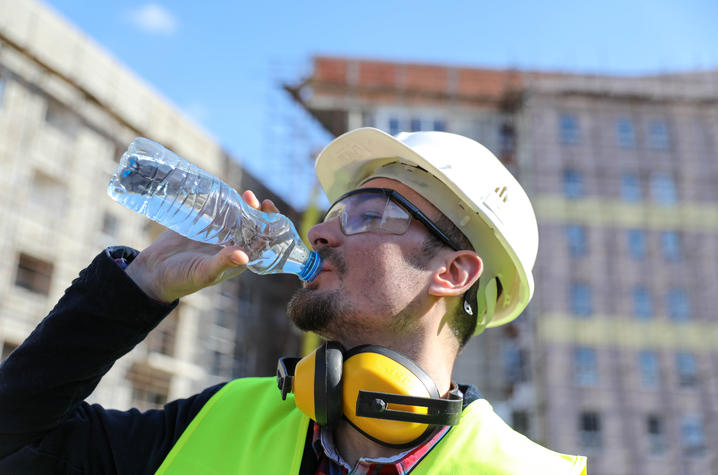Protect workers from heat illness: Know the dangers, act early

The University of Kentucky Public Relations and Strategic Communications Office provides a weekly health column available for use and reprint by news media. This week’s column is by Rebecca Honaker, program director for the Kentucky Occupational Safety and Health Surveillance Program at the Kentucky Injury Prevention and Research Center, based at the University of Kentucky College of Public Health.
LEXINGTON, Ky. (July, 28, 2025) — Heat is a serious workplace hazard that can cause illness — or even death — if proper precautions aren’t taken. Although outdoor workers face the greatest risk during high temperatures, indoor workers can also be affected, especially those working near heat sources or in poorly ventilated or non-air-conditioned spaces.
The United States Environmental Protection Agency reported that 986 workers across all industries died from exposure to heat in the U.S. from 1992 to 2022. Thirty-four percent of those fatalities were in the construction industry. The Kentucky Occupational Safety and Health Surveillance Program (KOSHS) found that 467 Kentucky workers visited the emergency department due to heat-related illnesses from 2019 to ’23.
According to the Occupational Safety and Health Administration (OSHA), three out of four heat-related deaths occur during a worker’s first week on the job. Employers should create and follow a plan to allow new and returning workers to acclimate to working in the heat. This should include shorter work periods with more frequent breaks, monitoring new workers for symptoms, and not allowing new workers to work alone. These increased precautions should last at least one to two weeks.
Employers should also take the following steps to protect workers who are working in hot environments:
- Modify work schedules with mandatory increased breaks in cooler areas, scheduling work at a cooler time of day and rotating job functions to help minimize exertion or heat exposure.
- Provide cool water for workers to drink and remind workers to drink regularly, not just when thirsty. For longer jobs that exceed two hours, employers should provide electrolyte-containing beverages.
- When possible, use methods to make the environment cooler with air conditioning, misting fans, increased ventilation, reflective shields, etc. Reduce manual workload with mechanization where possible.
- Ensure workers are wearing light colored, loose-fitting clothing that doesn’t trap heat or moisture. Some types of personal protective equipment can increase the risk of heat-related illness.
Employers should also train all supervisors and workers how to identify and control heat hazards, recognize signs and symptoms, administer first aid and to be ready to engage emergency medical services quickly.
Common signs of heat exhaustion can include:
- Headache, nausea, dizziness
- Weakness, irritability
- Thirst, decreased urine
- Heavy sweating
- Elevated body temperature
If an employee experiences these symptoms, action should be taken to cool them down. This can include moving them to cooler area, removing unnecessary clothing, providing cool water and cooling them with water, ice or a fan. They should not be left alone and should be monitored.
Heat exhaustion can progress to heat stroke if not treated promptly. Heat stroke is a life-threatening emergency, and if any of the following symptoms are observed, 911 should be called immediately:
- Slurred speech, confusion
- Loss of consciousness
- Hot, dry skin or profuse sweating
- Very high body temperature
- Seizures
The OSHA-NIOSH Heat Safety Tool is a free app that employers can download to monitor heat hazards in real-time. The app uses heat index data and hourly forecasts from the National Weather Service to assign risk levels specific to your geographic location. Precautionary recommendations are provided based on the heat index risk level. The app also allows quick access to symptoms of heat illness and tips for first aid.
UK HealthCare is the hospitals and clinics of the University of Kentucky. But it is so much more. It is more than 10,000 dedicated health care professionals committed to providing advanced subspecialty care for the most critically injured and ill patients from the Commonwealth and beyond. It also is the home of the state’s only National Cancer Institute (NCI)-designated Comprehensive Cancer Center, a Level IV Neonatal Intensive Care Unit that cares for the tiniest and sickest newborns and the region’s only Level 1 trauma center.
As an academic research institution, we are continuously pursuing the next generation of cures, treatments, protocols and policies. Our discoveries have the potential to change what’s medically possible within our lifetimes. Our educators and thought leaders are transforming the health care landscape as our six health professions colleges teach the next generation of doctors, nurses, pharmacists and other health care professionals, spreading the highest standards of care. UK HealthCare is the power of advanced medicine committed to creating a healthier Kentucky, now and for generations to come.




